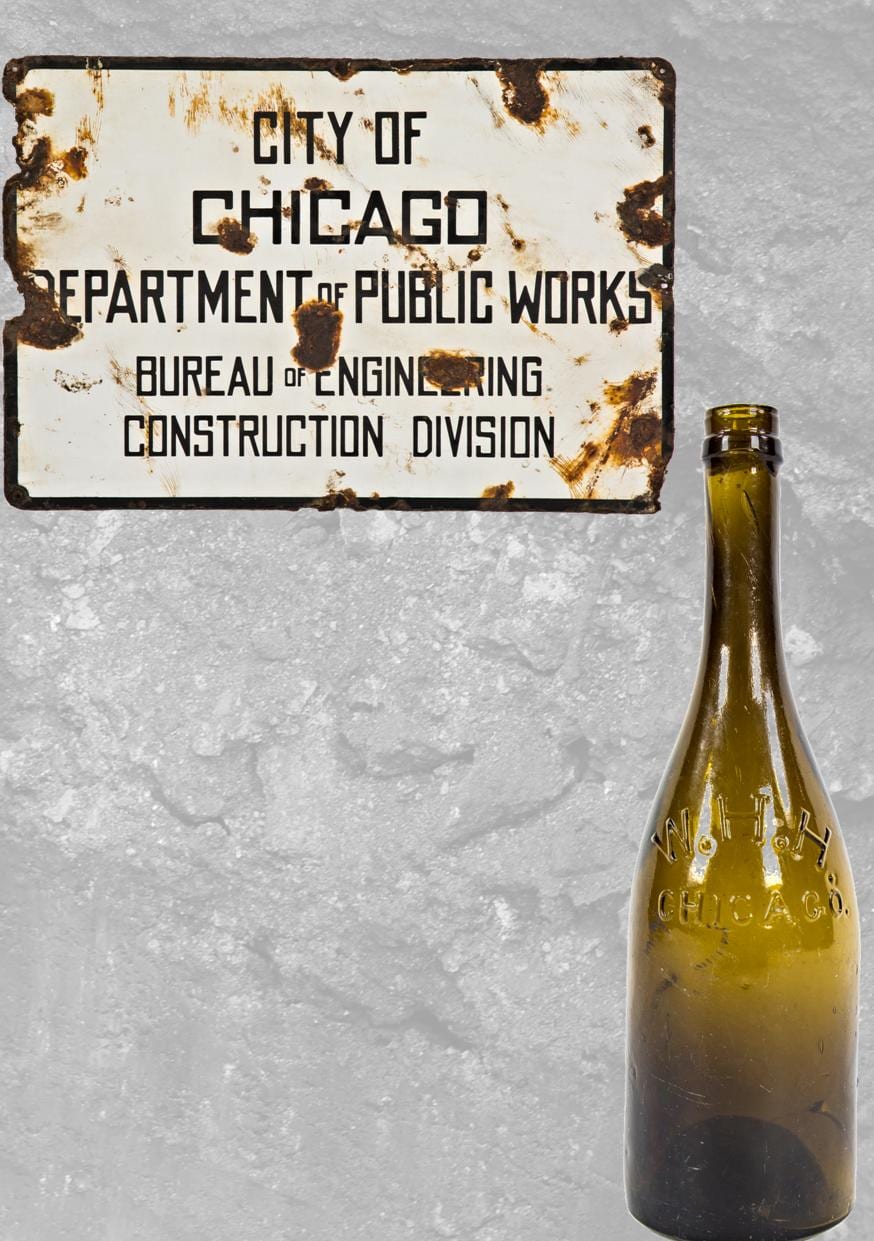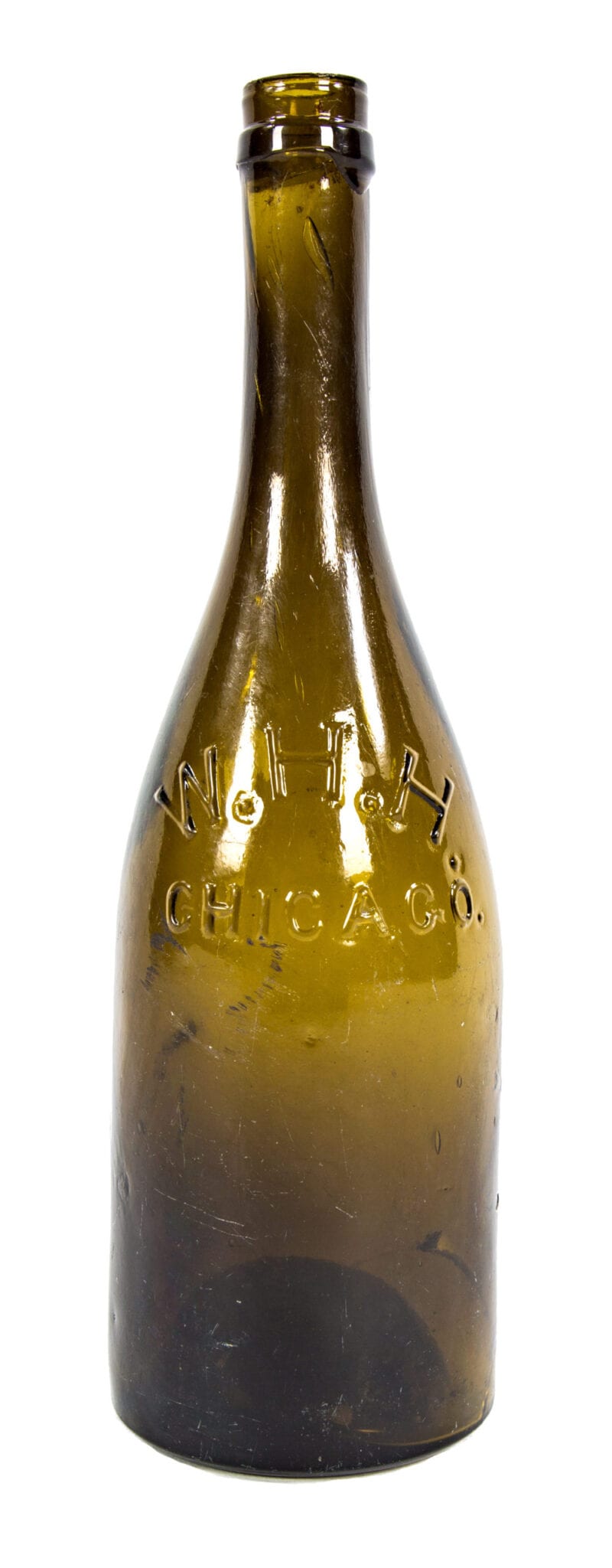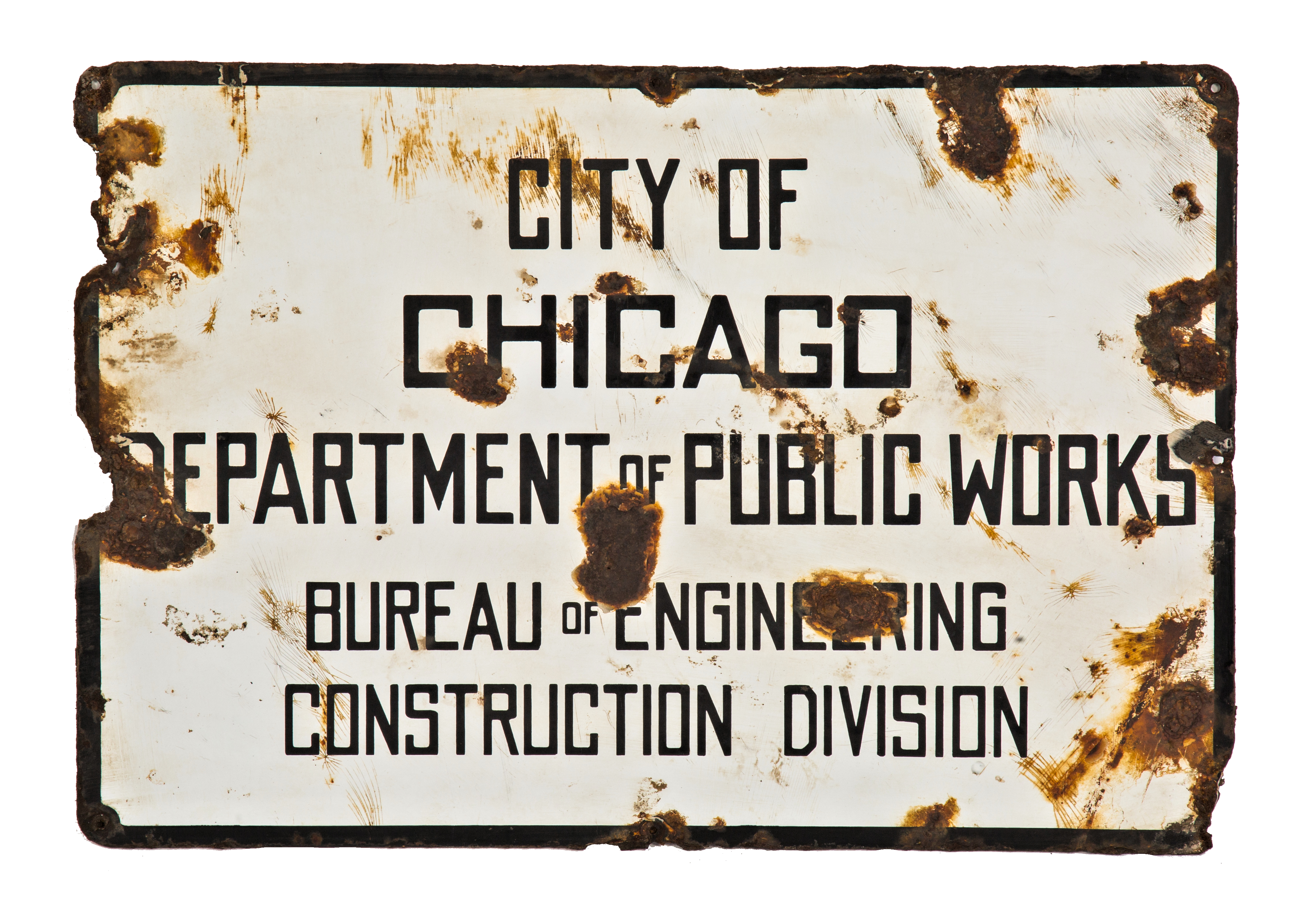artifacts dating from the 1860s recently unearthed from downtown chicago excavation site
This entry was posted on February 8 2018 by Eric

i finally had time to shoot these two artifacts unearthed from a downtown chicago dump a while back. the 1860's hutchinson "ring top" bottle was found 15 feet below grade. the single-sided porcelain enameled depression era chicago sign, dug from the same location, was found around 5 feet below grade.
i kills me that more wasn't recovered from this site. a cross-section showing layers of time through various chicago artifacts dating (in this case) from the civil war to the depression would've been a remarkable discovery.
discovered 15 feet below grade:

rare and exceptional chicago privy dug c. 1865-1867 richly colored green-yellow or chartreuse-colored champagne shaped quart size bottle manufactured for chicago bottler william henry hutchinson. the rounded body has a long sloping neck finished with an applied square ring lip. the front body is embossed "w.h.h. / chicago". william henry hutchinson moved to chicago in 1840. he opened a small chicago bottling plant in a dwelling on west randolph, between clinton and jefferson streets, in 1848. “hutchinson & company’s” first bottled products included spruce and lemon beers, cider, soda, and mineral water. oak barrels full of fresh water for carbonating were hauled by wagon from lake michigan. sodas and mineral waters were bottled in cobalt blue, long-neck, blob top, iron-pontiled bottles embossed “hutchinson & co”. these bottles are believed to have been blown by william mccully & company of pittsburgh, pennsylvania. in 1851 operations were moved to the corner of randolph and peoria streets (8 & 10 north peoria street). the hutchinson & company name was changed to “w. h. hutchinson & company” in 1855 and their new cobalt blue soda bottles were embossed w.h.h. / chicago. these newer bottles were similar to the earlier examples, but have smooth bases. some of them have “wm. mcc & co.” maker’s marks on the back heel, confirming their manufacture by mccully. in 1858, william h. hutchinson and t.o. dunn formed a partnership known as “hutchinson & dunn.” they bottled soda water, ale, and porter. no bottles are known listing this business name or their 242-245 west randolph street address. in 1863 dunn sold his interests to william h. hutchinson’s sons, william a. hutchinson and george c. hutchinson. the company name was then changed to “w. h. hutchinson & sons.” the “w.h.h.” trade mark, however, continued to be used for several years thereafter. w. h. hutchinson & sons’ bottles in the late 1860s/early 1870s included amber and aqua porter beers, amber wine-style quarts, round bottom ginger ales, and amber and green saratoga-style mineral waters. fortuitously, the w. h. hutchinson and sons’ bottling plant was located west of the business district devastated by the great chicago fire of 1871. one of the fire’s major casualties was chicago’s post office. the hutchinsons responded by donating thousands of wooden soda delivery cases that were used for sorting mail at a makeshift post office. although w. h. hutchinson and son survived the fire, the firm struggled as an economic depression hit the country and most of the company’s holdings had to be sold to stave off bankruptcy. in early 1879, william h. hutchinson died and his son william a. hutchinson retired. ownership of the firm then passed to george c. hutchinson and his younger brother, charles grove hutchinson. william h. hutchinson didn’t live the see the enormous success his firm achieved following charles g. hutchinson’s invention and registration of “hutchinson’s patent spring stopper” april 8, 1879. hutchinson’s stopper gained widespread popularity with bottlers and consumers as corks and most other types of external and internal bottle closures were rendered obsolete and hutchinson’s inexpensive internal stoppers became the north american soda bottling industry’s standard closure. the “hutchinson era” lasted from 1879 until just before world war i. hutchinson’s patent spring stopper is second only to painter’s crown closure in terms of total industry impact. in 1882, hutchinson’s bottling operations were sold to the hayes brothers, chicago soda bottlers since 1871. this major change in operations allowed w. h. hutchinson & son to focus on manufacturing and distributing hutchinson’s patent spring stoppers, syrups and extracts, and other major components of the bottling process. the plant was moved to 196-198 south desplaines street, chicago, in 1882. by the turn of the century the development of owens’ automatic bottle machine, passage of the pure food and drugs act of 1906, and the economic reality that crown seal closures (bottle caps) were sanitary, easily applied, and significantly less expensive than hutchinson’s patent spring stoppers were factors that led bottlers to gradually phase out hutchinson bottling equipment and convert to crown seal machinery. in 1912 w. h. hutchinson and son halted production of hutchinson stoppers in favor of manufacturing crown caps.
discovered 5 feet below grade:

single-sided depression era white and black porcelain enameled city of chicago "department of public works" flush mount sign. the largely intact sign is comprised of cold-rolled steel. the city sign remains in decent condition, considering it resided in a landfill for several decades before being unearthed earlier this month. the sign was fabricated by or for the read-made sign company, new york city, ny.
additional reading:
https://www.urbanremainschicago.com/news-and-events/2017/02/14/porcelain-enameled-advertising-signs-unearthed-around-chicago-dig-sites/
This entry was posted in , Miscellaneous, Bldg. 51, Events & Announcements, New Acquisitions, Featured Posts & Bldg. 51 Feed on February 8 2018 by Eric
WORDLWIDE SHIPPING
If required, please contact an Urban Remains sales associate.
NEW PRODUCTS DAILY
Check back daily as we are constantly adding new products.
PREMIUM SUPPORT
We're here to help answer any question. Contact us anytime!
SALES & PROMOTIONS
Join our newsletter to get the latest information

























